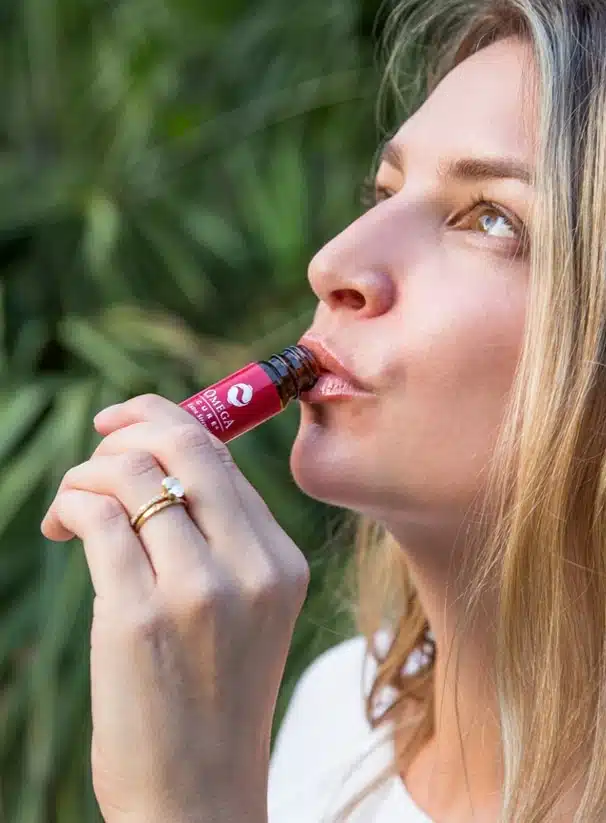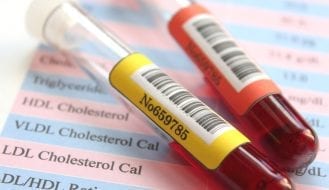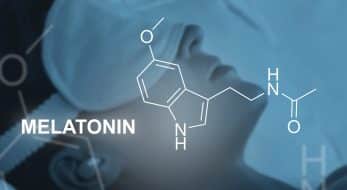Can Omega-3, Melatonin, & Vitamin D3 Fight Bone Density Loss?
How does our Omega Cure® fish oil impact people at risk for osteoporosis?
It was a question I had admittedly not paid too much attention to until a few months ago when one of our customers, Judith, visited me with a report from the spine center.
Judith and I had spoken one year earlier. At that point, she had confided in me that she had a family history of osteoporosis, and because of that, she was concerned and vigilant about her own bone health. She had been followed up for many years at a specialized clinic in Chicago and had tried different drugs to stop her declining bone mineral content, which averaged almost 2% every year without prescription medications.
I had seen some studies on the benefits of not just omega-3, but also melatonin, for bone health. So I suggested she try our new Omega Restore™ vials instead of the regular Omega Cure. Judith agreed and started using Omega Restore with 5 mg of melatonin every night.
When she visited me a year later, she told me that her doctors were amazed and had started ordering Omega Cure for themselves. Her new test results revealed a 5.7% increase in mineral bone density over the last 12 months, compared to the continuous reductions she had experienced in the previous 5 years.
Were the benefits Judith experienced pure coincidence, or did they have any scientific foundation? I decided to take a deeper look at the research.
Osteoporosis: A Growing Concern
Judith’s concerns about getting osteoporosis are well founded. It is projected that at least 1 in 3 women and 1 in 5 men will suffer a fragility fracture during their lifetime (1). In addition, the worldwide rates of incidence are growing.
Osteoporosis is becoming such a significant global issue that a recent survey from Hong Kong showed that over 70% of menopausal and postmenopausal women named osteoporosis as their biggest health concern, ahead of breast cancer and sleep problems (2).
The Relationship Between Sleep, Breast Cancer and Osteoporosis
What is interesting is that osteoporosis, sleep problems and some cancers seem to be related. For example, not only do breast cancer and common cancer treatments increase the risk of having sleep problems, but they also increase the risk of osteoporosis (3, 4, 5).
Several epidemiological studies have also shown that sleep disturbances (both sleeping more than 9 hours or less than 6) increase the risk of osteoporosis (6).
What the Research Shows
Our Omega Restore vials contain three primary ingredients that may have benefits related to osteoporosis: melatonin, omega-3 fatty acids, and vitamin D3.
I have written about how these ingredients impact breast cancer and sleep issues in previous articles. In this one, I will survey the science surrounding bone health.
Melatonin
While best known for its role in regulating the circadian rhythm, melatonin is indispensable for a multitude of cellular functions, including bone and tooth formation. In fact, some scientists believe that reduced melatonin production could in part explain why people become more prone to bone imbalances as they get older.
Researchers in Denmark looked at the effect of taking melatonin supplements in relationship to bone loss in postmenopausal women. They found that supplementing with 3 mg of melatonin for one year increased bone mineral density (BMD) of the femoral neck by 2.2% and volumetric BMD in the spine by 3.6% (7).
A 2017 American study noted similar findings. This study, which combined 5 mg of melatonin with vitamin D3 (as well as vitamin K2 and strontium), found that daily use increased BMD in the spine by 4.3% and the femoral neck by 2.2% (8).
Omega-3
Scientists also believe that getting enough omega-3 fatty acids could have a positive impact on bone health. Omega-3s are known for their ability to combat chronic inflammation, which can play a significant role in the onset of osteoporosis. In fact, chronic inflammation may disturb bone metabolism and prevent bone resorption, contributing to bone loss over time (9).
In observational studies, researchers have found that people with higher intakes of omega-3s generally have better bone mineral density numbers and a reduced risk of fragility fractures (10). Eating fish in particular seems to have a strong benefit for reducing the risk of fractures.
However, researchers note that these benefits depend on dose and source. For instance, in one study, the researchers found a positive correlation between the consumption of fish and bone mineral density in Koreans, but not in Americans. The researchers reasoned that this could be explained by the fact that the Koreans ate 4 to 5 as much fish as their American counterparts, and that the results highlighted the importance of meeting a minimum intake level in order to achieve benefits (11). This explanation is supported by another study showing that there is a clear relationship between the amount of omega-3s in the blood and bone mineral density (12).
Studies indicate that increased omega-3 intake, particularly from eating fish, may reduce the risk of fractures. But research also shows that it’s necessary to get an adequate omega-3 dose.
Vitamin D3
Of the three nutrient types, vitamin D is the best known for its role in promoting and maintaining healthy bones. Researchers originally made the connection between vitamin D and bone health thanks to cod liver oil, a common remedy for preventing rickets in the early 20th century (13). Since then, vitamin D has been extensively studied in order to determine its impact on bone fractures (14).
While vitamin D3 is widely used and recommended for people at risk of osteoporosis, clinical trials supplementing with vitamin D alone have found somewhat mixed results. Researchers note that this could be because of the low dose or form of vitamin D used (15).
Interestingly enough, until recently, the recommended dietary allowance of vitamin D3 was only 400 IUs. The scientific basis for this dose was that it approximated the amount of vitamin D in one teaspoon (5 mL) of unrefined cod liver oil, which had long been considered a safe and effective dose for preventing rickets (16).
Influences on the Gut Flora
In their recommendation of vitamin D, however, scientists may have ignored an important point: Raw cod liver oil is a nutrient-rich liquid containing not just vitamin D, but a multitude of substances, including omega-3 fatty acids and other vitamins. These ingredients synergistically interact together. In addition, they also impact the gut bacteria, which in turn influence vitamin D absorption and functionality (17).
Melatonin, fish oil and vitamin D3 all seem to have a strong and positive effect on the gut microbiota, much like pre and probiotics (18, 19, 20, 21, 22). Researchers consistently find that these nutrients increase microbial diversity and reduce the types of bacteria that manufacture inflammation-driving substances.
This is an extremely important point, since research also shows that most chronic diseases, including osteoporosis and many kinds of cancers, are accompanied by altered gut flora and diminished bacterial diversity (23, 24).
Liquid Supplements Versus Pills
The lack of ingredient synergy could perhaps explain why clinical trials show that vitamin D3 supplementation alone has a limited or inconsistent effect on osteoporosis.
This same logic could also clarify why traditional omega-3 capsules have not been significantly linked to improved bone health. Low dosages delivered via gel caps ensure that the contact surface with the bacteria is too small to significantly change gut flora.
I suspect this can also explain why melatonin appears to be more powerful when it is dissolved directly into our Omega Cure oil. Compared to taking melatonin in a pill, swallowing a liquid version would likely increase the contact with the gut bacteria (25, 26).
How do liquid versus pill supplements compare? Some studies examining the gut bacteria find that the two deliver different results.
The Importance of Patient Compliance in Preventing Osteoporosis
There are several treatment options and many medications that may help prevent bone mineral density loss and reduce fracture risk. But adherence to these osteoporosis treatments is notoriously poor, with some 30 – 60% of patients not taking their medications or following treatment plans as directed (27). Patients often reject the medications because of gastrointestinal problems and other side effects, or because they are inconvenient to take.
Looking at the research, I feel particularly encouraged by one note in the 2017 melatonin study: Over 92% of the participants complied with the research protocol. The researchers suspected that it was the inclusion of melatonin that made the difference for patient compliance. Because the patients noticed day-to-day benefits for their sleep, they likely felt more motivated to take their supplements as directed (8).
In talking with many of our customers who have been using our products for years, I notice a similar trend. Many customers take Omega Cure to help stave off joint discomfort or lower lipid levels. But, as life changing as Omega Cure can be, customers sometimes have trouble measuring or taking the appropriate dose daily. While not for everyone, the Omega Restore vials seem to encourage compliance because they are pre-measured and also contain melatonin.
If you have questions about Omega Restore or what you have read here, leave us a comment below or give us a call at 866.414.0188. We are always happy to talk with you and hear your feedback.
1. Facts and Statistics. International Osteoporosis Foundation, 2017.
2. Chow, L. W., Cheung, M. M., Chu, J. W., and Li, I. C. (2017). A Survey of Osteoporosis and Breast Cancer Risk Perception among Menopausal and Postmenopausal Women in Hong Kong. Journal of Menopausal Medicine, 23(2), 102–107.
3. Otte, J.L., Carpenter, J.S., Russell, K.M., Bigatti, S. and Champion, V.L. (2010). Prevalence, Severity, and Correlates of Sleep-Wake Disturbances in Long-Term Breast Cancer Survivors. Journal of Pain and Symptom Management, 39(3), 535-547.
4. Drake, M. T. (2013). Osteoporosis and Cancer. Current Osteoporosis Reports, 11(3), 163–170.
5. Bruyère, O. et al. (2017). Skeletal Health in Breast Cancer Survivors. Maturitas, 105, 78-82.
6. Saint Martin, M. et al. (2016). Does Subjective Sleep Affect Bone Mineral Density in Older People with Minimal Health Disorders? The PROOF Cohort. Journal of Clinical Sleep Medicine : JCSM : Official Publication of the American Academy of Sleep Medicine, 12(11), 1461–1469.
7. Amstrup, A.K., Sikjaer, T., Heickendorff, L., Mosekilde, L., Rejnmark, L. (2015). Melatonin Improves Bone Mineral Density at the Femoral Neck in Postmenopausal Women with Osteopenia: A Randomized Controlled Trial. Journal of Pineal Research, 59(2), 221-229.
8. Maria, S. et al. (2017). Melatonin-Micronutrients Osteopenia Treatment Study (MOTS): A Translational Study Assessing Melatonin, Strontium (Citrate), Vitamin D3 and Vitamin K2 (MK7) on Bone Density, Bone Marker Turnover and Health Related Quality of Life in Postmenopausal Osteopenic Women Following a One-Year Double-Blind RCT and on Osteoblast-Osteoclast Co-Cultures. Aging, 9(1), 256–285.
9. Redlich, K. and Smolen, J.S. (2012). Inflammatory Bone Loss: Pathogenesis and Therapeutic Intervention. Nature Review Drug Discovery, 11(3), 234-50.
10. Longo, A.B. and Ward, W.E. (2016). PUFAs, Bone Mineral Density, and Fragility Fracture: Findings from Human Studies. Advances in Nutrition, 7(2), 299-312.
11. Eunjin Choi, E. and Youngsoon, P. (2016). The Association between the Consumption of Fish/Shellfish and the Risk of Osteoporosis in Men and Postmenopausal Women Aged 50 Years or Older. Nutrients, 8(3), 113.
12. Orchard, T. S., Ing, S. W., Lu, B., Belury, M. A., Johnson, K., Wactawski-Wende, J. and Jackson, R. D. (2013). The Association of Red Blood Cell N-3 and N-6 Fatty Acids to Dietary Fatty Acid Intake, Bone Mineral Density and Hip Fracture Risk in The Women’s Health Initiative. Journal of Bone and Mineral Research : The Official Journal of the American Society for Bone and Mineral Research, 28(3), 505–515.
13. O’Riordan, J. H. and Bijvoet, O. M. (2014). Rickets Before the Discovery of Vitamin D. BoneKEy Reports, 3, 478.
14. Martineau, A. and Jolliffe, D. (2014). “Vitamin D and Human Health: from the Gamete to the Grave”: Report on a meeting held at Queen Mary University of London, 23rd–25th April 2014. Nutrients, 6(7), 2759–2919.
15. Drugs to Prevent Bone Fractures in People with: Osteoporosis. Consumer Reports Best Buy Drugs™. September 2013.
16. Vieth, R. (1999). Vitamin D Supplementation, 25-hydroxyvitamin D Concentrations, and Safety. The American Journal of Clinical Nutrition, 69(5), 842-856.
17. Luthold, R.V., Fernandes, G.R., Franco-de-Moraes, A.C., Folchetti, L.G. and Ferreira, S.R. (2017). Gut Microbiota Interactions with the Immunomodulatory Role of Vitamin D in Normal Individuals. Metabolism, 69, 76-86.
18. Paulose, J. K., Wright, J. M., Patel, A. G., and Cassone, V. M. (2016). Human Gut Bacteria Are Sensitive to Melatonin and Express Endogenous Circadian Rhythmicity. PLoS ONE, 11(1), e0146643.
19. Xu, P. et al. (2017). Melatonin Prevents Obesity Through Modulation of Gut Microbiota in Mice. Journal of Pineal Research, 62(4).
20. Cui, C. et al. (2017). Modulation of the Gut Microbiota by the Mixture of Fish Oil and Krill Oil in High-Fat Diet-Induced Obesity Mice. PLoS One, 2(10), e0186216.
21. Costantini, L., Molinari, M., Farinon, B. and Merendino, N. (2017). Impact of Omega-3 Fatty Acids on the Gut Microbiota. International Journal of Molecular Sciences, 18(12), 2645.
22. Frontiers. Vitamin D Improves Gut Flora and Metabolic Syndrome: Extra Vitamin D Can Restore Good Bacteria in the Gut, According to a Study in Mice. ScienceDaily, December 21, 2016.
23. Weaver, C. M. (2015). Diet, Gut Microbiome, and Bone Health. Current Osteoporosis Reports, 13(2), 125–130.
24. Zhang, Y.-J., Li, S., Gan, R.-Y., Zhou, T., Xu, D.-P., & Li, H.-B. (2015). Impacts of Gut Bacteria on Human Health and Diseases. International Journal of Molecular Sciences, 16(4), 7493–7519.
25. Watson, H. et al. (2017). A Randomised Trial of the Effect of Omega-3 Polyunsaturated Fatty Acid Supplements on the Human Intestinal Microbiota. Gut, pii: gutjnl-2017-314968.
26. Lee, T. et al. (2017). Oral Versus Intravenous Iron Replacement Therapy Distinctly Alters the Gut Microbiota and Metabolome in Patients with IBD. Gut, 66(5), 863–871.
27. Warriner, A. H. and Curtis, J. R. (2009). Adherence to Osteoporosis Treatments: Room for Improvement. Current Opinion in Rheumatology, 21(4), 356–362.
Recent Posts
-
Dose, Joint Health, Omega-3
Omega-3 & Pain Relief: Finding the Best Strategy
Are you one among the 1 in 5 Americans grappling with chronic pain, as reported by the CDC [1]? If the thought of traditional pain medications and their potential side...3 months ago -
Eye Health, Omega-3
The Startling Link Between Skin Care and Eye Health
Dry eye complaints are on the rise worldwide. Many risk factors – including aging and increased computer use – help explain the increase. But there's another driver few people know...6 months ago -
Heart Health
Does Taking Fish Oil Lower Cholesterol?
Many people believe that incorporating omega-3s into their diet will solve their cholesterol woes. But the truth is much more nuanced; it's not as simple as taking a daily fish...1 year ago -
Immune Health, Sleep
Melatonin & COVID-19: Can This ‘Sleep Hormone’ Help?
It started with a runny nose and a slight cough. But when his 72-year-old wife tested positive for COVID-19, he got concerned. “Is there any research suggesting the supplements we...2 years ago -
Full-Spectrum Fish Oil, Omega-3
Is It Good to Store Fish Oil in the Freezer?
Fish oil is a great source of the omega-3 fatty acids we all need for good health. It’s also highly perishable. Consuming rancid fish oil can have negative health implications....2 years ago -
Omega-3
Our Favorite Omega-3 Fish Oil Benefits
Omega-3 fish oil certainly has a reputation for delivering a plethora of incredible benefits. And it’s true! Omega-3 fatty acids have been studied for a broad range of health conditions....2 years ago












